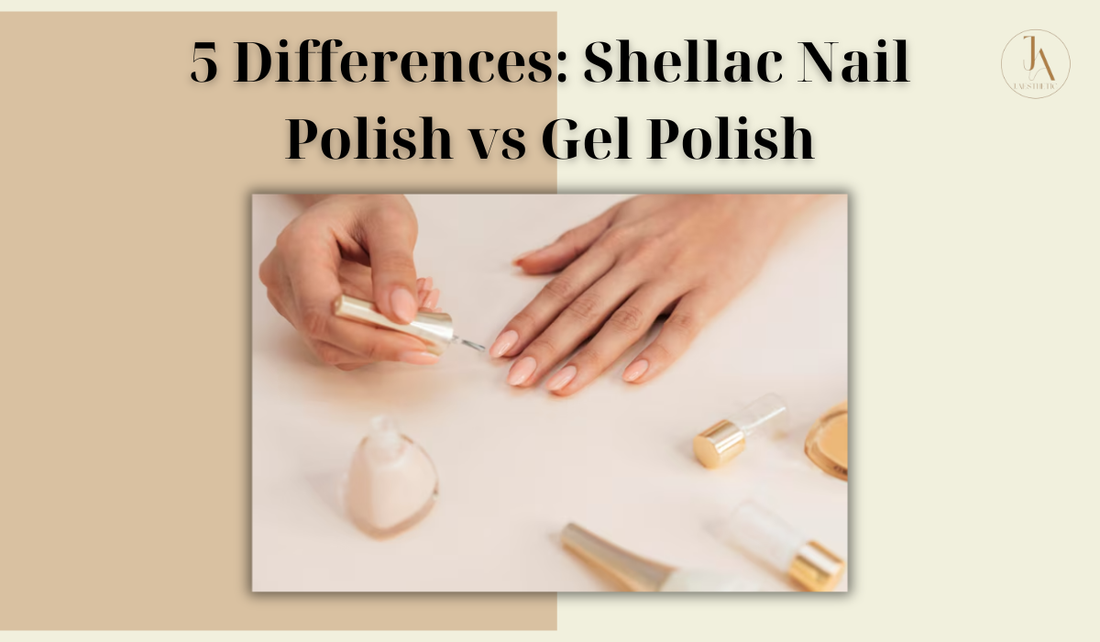
Shellac Nail Polish vs Gel Polish: 5 Differences
Share
When comparing Shellac nail polish vs gel polish, most clients only consider how long each lasts - but the true differences run deeper. These two light‑cured systems differ in formula, feel, removal, and how they interact with your natural nail plate. While both deliver high‑gloss, chip‑resistant results, the choice you make determines how your nails look and stay healthy over time.
This step‑by‑step comparison explains the five biggest differences between Shellac and gel polish - covering their formulation, finish, wear time, removal, and long‑term nail impact - so you can confidently choose the right manicure for your nail type and lifestyle.

1. Formula & Thickness: Hybrid Polish vs Pure Gel
The core distinction between Shellac and gel begins with chemistry. Shellac, developed by CND (Creative Nail Design), is a hybrid system that merges regular nail polish with gel polymers. Its lightweight consistency mimics traditional polish but benefits from gel’s curing technology. The result is a flexible coating that hugs the natural nail without adding bulk.
Gel polish, in contrast, is composed of 100% gel resin polymers. This makes it denser, more elastic, and capable of forming a stronger barrier over the nail surface. Because of its viscosity, gel polish can also be layered to shape or slightly thicken the nail, helping those with brittle or uneven nail plates. However, that density requires slightly more care during removal.
In short:
-
Shellac feels thin, breathable, and natural.
-
Gel polish feels structured, smooth, and fortified.
If you prefer a lighter feel with easy colour changes, Shellac is ideal. For long wear or added nail support, gel polish performs better.

2. Application & Shine: Subtle vs Sculpted Finish
The application process for Shellac and gel looks similar but delivers different results. Both start with nail prep - shaping, cleaning, and dehydrating the nail plate - followed by a base coat, two colour coats, and a sealing top coat. Each layer is cured under LED or UV light to harden and set the finish.
Shellac’s formula applies more fluidly, allowing for faster service time - usually around 30 minutes. Its self-leveling nature ensures an even coat without added thickness, creating a clean, high‑gloss result that mirrors natural nails. This makes it especially suited for professionals, minimalists, or anyone who dislikes the heavy feel of thick polish.
Gel polish, on the other hand, requires more control and curing time. Each layer is slightly thicker, allowing technicians to sculpt the nail’s curve for a more defined shape. The payoff is a richer shine, longer wear, and the versatility to include nail art, glitter, or ombré designs that Shellac cannot easily replicate.
If your priority is subtle elegance, Shellac delivers. If you want a salon‑sculpted finish that lasts longer, gel is the better match.
3. Wear Time & Durability: Short‑Term Flexibility vs Long‑Term Strength
Durability is one of the most noticeable differences between these two systems. Shellac manicures last around 10–14 days, depending on lifestyle and aftercare. Its thinner layers allow some flexibility, so it’s less likely to crack but may chip sooner under frequent handwashing or manual work. Shellac is perfect for clients who like to refresh their nails more often or switch colours regularly.
Gel polish lasts between 2–3 weeks - sometimes longer. The denser resin forms a strong coating that resists everyday stress like cleaning, typing, or frequent exposure to water. It’s ideal for people whose nails easily bend or peel because the structured coating keeps everything protected. However, its very strength can make removal slightly more labour‑intensive.
The trade‑off is simple:
-
Shellac = flexibility, convenience, and quicker changes.
-
Gel = endurance, resilience, and longer wear.
Either can look immaculate - but the right choice depends on how you live and work.

4. Removal Process: Fast Soak vs Careful Filing
Removal is where the user experience diverges most clearly. Shellac was engineered to be quickly and safely removed. After gently buffing the surface, each nail is wrapped in acetone‑soaked cotton and foil. Within 8–10 minutes, the polish lifts away cleanly, leaving the natural nail intact. Minimal scraping and filing are required, making it a gentle option even for thin or sensitive nails.
Gel polish removal depends on the type used. Soft gels can also be soaked off, but hard or builder gels must be carefully filed down before acetone application. Improper removal - such as peeling or aggressive scraping - can strip the nail’s top layers and cause long‑term weakness. This is why professional removal is strongly recommended.
If you value quick, low‑maintenance sessions, Shellac offers an easier process. If you choose gel, investing in professional aftercare ensures healthy results without compromise.
5. Nail Health & Long‑Term Impact
Both systems can maintain nail health when applied and removed correctly, but their impact differs slightly. Shellac is the gentler choice: it adds minimal thickness and requires no heavy buffing. Because it sits lightly on the nail, it’s less likely to trap moisture or cause lifting when exposed to water.
Gel polish, while more protective during wear, can dry or thin the nail if removed incorrectly. Over‑filing the surface or soaking too long in acetone can lead to brittle nails or sensitivity. However, when handled by professionals, gel can actually help stabilise fragile nails, acting as a shield during regrowth.
Modern salons, including J.Aesthetic, often use HEMA‑free or low‑acrylate systems to reduce allergic reactions and improve safety for frequent wearers. Pairing manicures with hydrating cuticle oils and nail serums keeps both Shellac and gel nails strong over time.

Shellac vs Gel Polish: Side‑by‑Side Comparison
Before choosing, review the comparison table below. It summarises how Shellac and gel differ in formula, process, and performance.
|
Category |
Shellac Nail Polish |
Gel Polish |
|
Formula Type |
Hybrid (polish + gel polymers) |
Pure gel resin |
|
Application Time |
~30 minutes |
45–60 minutes |
|
Finish |
Thin, lightweight gloss |
Thick, sculpted shine |
|
Durability |
10–14 days |
2–3 weeks or longer |
|
Removal |
Quick soak‑off (8–10 mins) |
Soak‑off or file + soak (15–20 mins) |
|
Nail Feel |
Natural and flexible |
Structured and reinforced |
|
Best For |
Healthy nails, frequent colour changes |
Weak nails, long wear, nail art |
Both deliver salon‑quality results - the decision ultimately depends on your priorities: flexibility versus endurance.

FAQs: Shellac vs Gel – What Clients Ask Most
Before booking, most salon clients want to know how Shellac and gel fit into their routines. Below are detailed answers based on real search data and salon experience.
How do you remove Shellac without damaging your nails?
To remove Shellac safely, gently file the surface to break the seal, then wrap each nail in acetone‑soaked cotton and foil for about 10 minutes. Once the coating softens, use a cuticle pusher to lift it away gently. Never peel or scrape off Shellac, as this can remove nail layers. Finish with cuticle oil to rehydrate. This gentle soak‑off process preserves the nail’s smooth surface and prevents brittleness.
Which is better for thin or weak nails?
Gel polish tends to offer better protection for weak nails because of its thicker structure. It acts like armour, reducing bending or splitting. Shellac, while lightweight, doesn’t add much support - so it’s better for strong nails needing a polished appearance. If your nails are thin but sensitive, structured gels or BIAB (Builder in a Bottle) systems provide reinforcement without harsh removal.
Do both Shellac and gel need UV or LED light?
Yes, both use curing lamps to harden each layer. Shellac was initially formulated for UV lamps but now cures under LED, which shortens exposure time and reduces heat spikes. Gel polish is compatible with both, though LED is preferred for efficiency and safety. Always match your lamp type to the brand’s specifications for optimal curing and longevity.
Which one is more cost‑effective?
Shellac manicures typically cost slightly less and take less time, but the polish must be redone more often. Gel manicures cost a little more initially, yet last longer, which can reduce total salon visits over several months. Ultimately, the more cost‑effective option depends on your frequency of wear and desired maintenance schedule.
Should I take breaks between Shellac and gel manicures?
Yes - taking periodic breaks is essential for nail health. After every 6–8 weeks of continuous wear, allow nails to rest for one or two weeks. During this time, use cuticle oil, keratin serums, and strengthening treatments to rehydrate the nail plate. Alternatively, switch to a lighter service like BIAB to maintain structure while promoting natural recovery.
Final Thoughts: Choosing the Right Manicure at J.Aesthetic
The best choice between Shellac and gel polish comes down to lifestyle and preference. If you want quick, flexible manicures with easy removal and natural shine, Shellac is perfect. If you need long‑wear protection and sculpted strength, gel polish delivers unbeatable resilience.
At J.Aesthetic Sydney, every manicure is tailored to your nail condition and routine. Our technicians use premium, low‑odor, and HEMA‑free products to ensure your nails remain beautiful and healthy between visits.
Book Your Gel Manicure in Sydney
From Soft Gel to Hard Gel, BIAB, Shellac and Polygel, J.Aesthetic in Gladesville offers custom gel manicure styles designed for every nail type and lifestyle. Experience expert care with a focus on precision, artistry, and lasting shine.
Book Your Appointment📍 267 Victoria Rd, Gladesville NSW 2111 | 📞 +61 2 3821 9828



